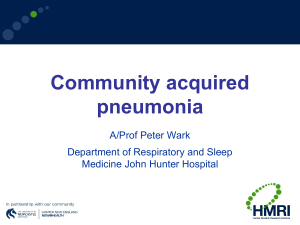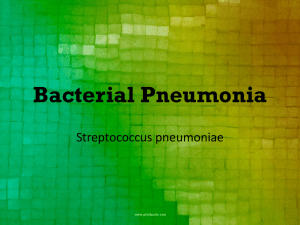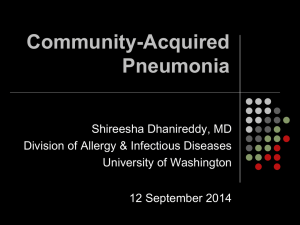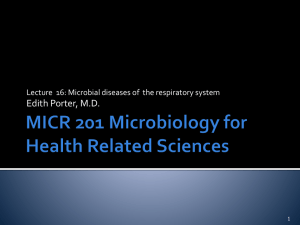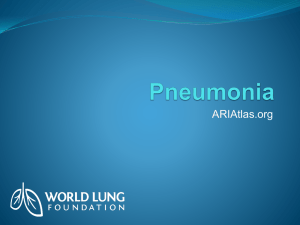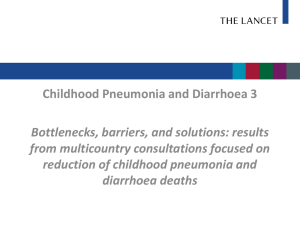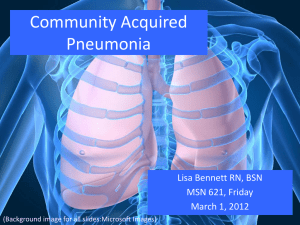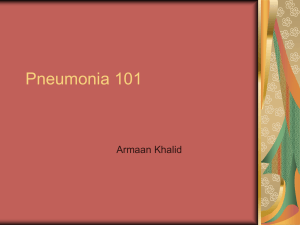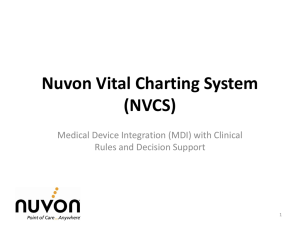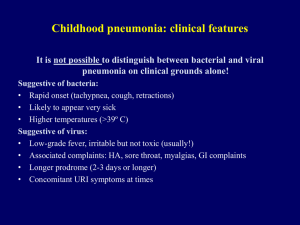อ.อารยา pneumonia_140356
advertisement
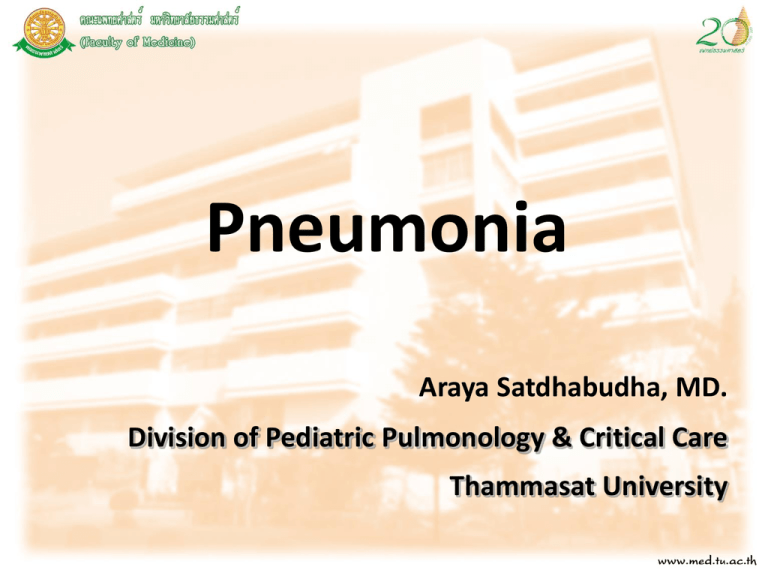
Pneumonia Araya Satdhabudha, MD. Division of Pediatric Pulmonology & Critical Care Thammasat University Epidemiology • Pneumonia is a common problem in children • Particularly in children under 5 years • Incidence 156 million children/year – 95% in developing country – 7-13% faced with severe pneumonia • 0.29 episode/child-year in developing country • 0.05 episode/child-year in developed country • Pneumonia is the leading cause of death in developing country Bull World Health Organ 2008 Epidemiology and etiology of childhood pneumonia World Health Organization Bulletin of the World Health Organization 2004 Epidemiology : developing countries In 1998 • 10 million of children < 5 yrs were died each year – 3 million child died from pneumonia (most from measles, pertussis) Recent data • Pneumonia still cause around 2 million children’s death annually – About 20% of all child death – 70% in Africa and Asia – Africa and Asia record 2-10 times more children with pneumonia than in USA Bull World Health Organ 2008 Epidemiology : Thailand • 45-50 % of LRTI in children under 5 years are diagnosis as pneumonia • Pneumonia is the leading cause of death in children under 5 years • 19% of fatal children are caused by pneumonia (2 million children/year) J Med Assoc Thai 2002 Lancet 2005 ข้อมูลจาก สำนักระบำดวิทยำ กรมควบคุมโรค กระทรวงสำธำรณสุ ข ปี 2548-2553 ข้อมูลจาก สำนักระบำดวิทยำ กรมควบคุมโรค กระทรวงสำธำรณสุ ข ปี 2548-2553 ข้อมูลจาก สำนักระบำดวิทยำ กรมควบคุมโรค กระทรวงสำธำรณสุ ข ปี 2548-2553 ข้อมูลจาก สำนักระบำดวิทยำ กรมควบคุมโรค กระทรวงสำธำรณสุ ข ปี 2548-2553 ข้อมูลจาก สำนักระบำดวิทยำ กรมควบคุมโรค กระทรวงสำธำรณสุ ข ปี 2546-2555 Pneumonia Bulletin of the World Health Organization 2004 Risk factors • Low birth weight (premature, SGA) – 20% of children born in developing countries have birth weight under 2,500 gm. • Under- nutrition, hypovitaminosis A, Zinc def. – W/A Z score of <-2 to -3 had 2-3 higher risk of death due to ALRI (Am J Epidemilo 1996) • Lack of breastfeeding – Motality rate associated with both ALRI and diarrhoae was increased 6 times by not breastfeeding • Air pollution : – Household use of fuels – ETS : RR of 1.2 for ARI in maternal smoking (J Infect Dis 1988) • Overcrowding : day-care centers Paediatric Respiiratory reviews 2005 Etiology •15-60% : cannot identify the pathogen •Age is a good predictor of the likely causative agent Age (years) Pathogen Neonatal period GBS, Gram negative enteric bacteria, CMV, L. monocytogenes 1 mo – 3 mos Virus : RSV, PIF Bacterial : S. pneumoniae, H. influenzae, B. pertussis, S. aureus C. trachomatis 3 mos – 5 yrs Virus : RSV, PIF, influenza, adenovirus, hMPV, rhinovirus Bacteria: S. pneumoniae, H. influenzae 5 – 15 yrs M. pneumoniae, C. pneumoniae, S. pneumoniae Kendig’s Disorders of Resp Tract in Children 2012 JID 2004 N Engl J Med 2002 Clinical evaluation • Fever • Cough • Dyspnea Atypical pneumonia : may be no fever May be absent in early stage of LRI Tachypnea : the most sensitive sign sensitivity 74% specificity 67% Nasal flaring, Retractions, Chest indrawing Grunting : impending respiratory failure Crepitation Wheezing : auscultation may not be present in early pneumonia Paediatric respiratory reviews 2000 Arch Dis child 2000 WHO’s age - specific criteria for tachypnea Age < 2 mo : RR > 60/min Age 2-12 mo : RR > 50/min Age 1 – 5 yrs : RR > 40/min Age > 5 yrs : RR > 30/min Clinical clue for CAP • Daycare attendance :Viral infection, DRSP • Exposure to infectious diseases : Viral or Mycoplasma infection, Tb • Hospitalization : Nosocomial infection • Missing immunizations : H. influenzae, pertussis, measles • Antibiotic therapy within previous month : Infection with resistant bacterial strains • Recent travel : influenza, SARS Investigations •blood culture in all hospitalized children but low blood culture yield (< 10%) J Infection 2004; 48: 134-8 •Blood culture in child with high fever or looked sepsis. BTS CAPvirus in children.thorax 2011 NP guidelines aspirateforfor in all children aged < 18 months (highly specific and sensitive) J Infection 2004; 48: 134-8. Investigation for CAP in children Clinical clue Labs CBC ESR CRP G/S and culture Chest radiograph Suggested Dx or interpretation Not helpful in distinguish etiology Not helpful in distinguish etiology Not helpful in distinguish etiology Helpful if specimen is adequate Not helpful in distinguish etiology . Am Fam Physician 2004; 70:899-908 CXR – CXR may not be abnormal at the start of classical pneumonia – If all the physical signs of pneumonia are not present, CXR are unlikely to be helpful. – The child should be perform CXR, when • • • • Age < 5 yrs without localizing sign Complicated pneumonia : pleural effusion, atelectasis Atypical presentation Not respond to antibiotic with in 48-72 hr. BTS guideline for CAP pneumonia in children, Thorax 2011 Paediatric respratory review 2000 Suggestive features of bacterial LRI clinical CXR Fever > 38.5○C •alveolar process, abrupt onset • lobar consolidation dyspnea crepitation Kendig and Chernik’s disorders of the respiratory tract in children.2012.. Am Fam Physician 2004; 70:899-908. Suggestive features of viral LRI clinical CXR Infants and young children Hyperinflation fever < 38.5○C interstitial process gradual onset patchy collapse (25%) dyspnea crepitation, wheeze Suggestive features of mycoplasma LRI clinical CXR School aged children Interstitial infiltrate, fever (30%), Cough(90%), rales (62%), wheeze /rhonchi(36%) lobar consolidation and hilar adenopathy Kendig and Chernik’s disorders of the respiratory tract in children.2012.. Extrapulmonary manifestation BTS Guideline. Thorax 2011 Am Fam Physician 2004; 70:899-908. Microbiological investigations : bacteria Investigations Recommendations Blood culture In children with high fever or looked sepsis NP aspirate for bacterial c/s Not recommend due to not adequate specimen Tracheal suction for g/s,c/s Recommened if adequate specimen Pleural aspirate (if present) Recommened for microscopy, culture and bacterial Ag detection Serum Ag (bacterial) Not recommend as tests are less sensitive and specific Serum Ab, immune cpx, paired serum Recommened, good sensitivity and speificity for S.pneumoniae PCR (serum, pleural fluid, secretion) High sensitivity and specificity for S.pneumoniae Bacterial Ag in urine Not recommend esp in young children due to poor specificity BTS guidelines for CAP in children.thorax 2011 J Infection 2004 Microbiological investigations : atypical pneumonia and virus Investigations Recommendations NP aspirate for viral Ag/PCR/culture highly specific and sensitive for RSV, parainfluenza, influenza and adenovirus Viral serology Acute and convalescent serum (if diagnosis not made with NP aspirates) M. pneumoniae Cold agglutinin (PPV 70%), serum IgM (in the 2nd wk) or 4-fold rising of paired serum IgG, +ve PCR of NP secretion C. pneumoniae Serum IgM or 4-fold rising of paired serum IgG, +ve PCR of NP secretion C. trachomatis Culture or PCR identification in NP secretion, IgM antibody BTS guidelines for CAP in children.thorax 2011 J Infection 2004. Management Severity assessment Mild Infants BT < 38.5 C RR < 70 Mild retraction Taking full feed Older children BT < 38.5 C RR < 50 Mild breathlessness No vomiting Severe BT > 38.5 C RR > 70 Moderate to severe retraction Cyanosis, apnea, grunting Not feeding BT > 38.5 C RR > 50 Difficulty breathing Nasal flaring, cyanosis, grunting Sign of dehydration BTS guidelines for CAP in children.thorax 2011 Indication for admission • • • • • • • • • Age < 3 months Desaturation (SpO2 < 92% in roomair) Dyspnea(increase WOB, retraction, grunting Poor feeding or dehydration Lethalgy or sign of shock : peripheral cyanosis, poor capillary refill S.aureus pneumonia Underlying disease: CHD, CLD, immune def. Clinical not improve within 48 hr after Rx Family not able to provide appropriate observation or supervision BTS guidelines for CAP in children.thorax 2011 Indications for PICU admission • Require FiO2 > 0.6 to maintain SpO2 > 92% • Shock • Sever respiratory distress, exhaustion (rising RR and PR ± ↑PaCO2) • Recurrent apnea • Slow, irregular breathing BTS guidelines for CAP in children.thorax 2011 General management At home • Supportive and symptomatic treatment for – Fever – cough – preventing dehydration : force oral fluid as tolerate – identifying any deterioration • The child should be reviewed by the doctor if – Deteriorating – not improved after 48 hrs of treatment BTS guidelines for CAP in children.thorax 2011 At hospital • Oxygen therapy: – In child with dyspnea, cyanosis, desaturation – maintain SpO2 > 92% • Fluid therapy : – Avoid nasogastric tube – Start iv fluid : mark dyspnea, abdominal distension, dehydration – Avoid volume overload, monitor serum electrolytes • • • • Managing fever and pain Bronchodilator inhaled : wheezing or rhonchi Physiotherapy (no role in distress, acute pneumonia) Frequent monitoring (vital signs, SpO2, lung signs, respiratory pattern BTS guidelines for CAP in children.thorax 2011 Specific treatment Clinical Practice Guideline for Treatment of Childhood Pneumonia in Thailand ชมรมโรคระบบหำยใจและเวชบำบัดวิกฤตในเด็ก พ.ศ. 2555 Mild pneumonia 1-3 mos 3 mo-15 yrs Amoxycillin/macrolides amoxycillin macrolides Improve Not improve Improve Admit Continue ATB 5-7 days Rx as severe pneumonia Continue ATB 7-10 days Not improve Improve Continue ATB Worse Worse Admit Rs as severe pneumonia Not improve Not worse - No complication : Rx atypical or DRSP -complication : admit Admit Rx as severe pneumonia Not worse Rx complication Severe pneumonia < 1 month 1 mo – 15 yr Ampicillin or PGS/ampicillin + aminoglycoside or 3rd gen cephalosporin 3rd generation cephalosporin if suspected DRSP Or cloxacillin if suspected S.aureus ±macrolide if suspected atypical pathogen 2 days Not improve Improve Reevaluate Continue ATB total coruse 7-10 days CXR Oral antibiotic for CAP Intravenous antibiotics for CAP Antiviral drug MMWR Jan 2011 Prevention • Promote adequate nutrition including breastfeeding and zinc intake • Raising immunization rate – – – – – Pneumococcal conjugated vaccine Hib vaccine Measles vaccine Pertussis vaccine Influenza vaccine • Reducing indoor pollution – Household use of fuels – Environmental tobacco smoke • Hand washing BTS guidelines for CAP in children.thorax 2011 Paediatric Respiratory Rewiews 2011 Thank you for your attention
